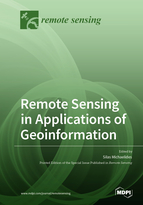Remote Sensing in Applications of Geoinformation
A special issue of Remote Sensing (ISSN 2072-4292).
Deadline for manuscript submissions: closed (31 October 2020) | Viewed by 50478
Special Issue Editor
2. ERATOSTHENES Centre of Excellence, Limassol 3036, Cyprus
Interests: atmospheric energetics; development of mathematical methods for weather prediction and their verification; diagnostic investigation of Mediterranean depressions with emphasis on the quantification of various characteristics; applications of artificial neural networks in meteorological and climatological issues; desert dust transportation; applications of weather radar in the estimation of precipitation; applications of satellite meteorology and remote sensing; precipitation, drought, floods and methods for their prediction and mitigation planning; atmospheric and climatic models
Special Issues, Collections and Topics in MDPI journals
Special Issue Information
Dear Colleagues,
Remote Sensing, especially from satellites, is a source of invaluable data which can be used to generate synoptic information for virtually all parts of the Earth, including the atmosphere, land, and ocean. In the last few decades, such data have evolved as a basis for accurate information about the Earth, leading to a wealth of geoscientific analysis focusing on diverse applications. Geoinformation systems based on remote sensing are increasingly becoming an integral part of the current information and communication society. The integration of remote sensing and geoinformation essentially involves combining data provided from both, in a consistent and sensible manner. This process has been accelerated by technologically advanced tools and methods for remote sensing data access and integration, paving the way for scientific advances in a broadening range of remote sensing exploitations in applications of geoinformation.
This Special Issue will host original research papers focusing on the exploitation of remote sensing from satellites, but also from various other platforms, in applications of geoinformation. The papers’ emphasis can be from a wide range of such applications. Indicatively, papers can focus on, but are not limited to, atmosphere, ocean, coastal waters, agriculture, forestry, land cover, land use, natural hazards, urban and rural environments, urban planning, public health, meteorology, climate change, oceanography and coupled ocean and atmosphere modelling, cultural heritage and archaeological reconstruction, military, environmental modeling and analysis, biodiversity conservation, transport including maritime and aviation, transportation and infrastructure, mineral exploration, erosion, hydrology, etc.
Dr. Silas Michaelides
Guest Editor
Manuscript Submission Information
Manuscripts should be submitted online at www.mdpi.com by registering and logging in to this website. Once you are registered, click here to go to the submission form. Manuscripts can be submitted until the deadline. All submissions that pass pre-check are peer-reviewed. Accepted papers will be published continuously in the journal (as soon as accepted) and will be listed together on the special issue website. Research articles, review articles as well as short communications are invited. For planned papers, a title and short abstract (about 100 words) can be sent to the Editorial Office for announcement on this website.
Submitted manuscripts should not have been published previously, nor be under consideration for publication elsewhere (except conference proceedings papers). All manuscripts are thoroughly refereed through a single-blind peer-review process. A guide for authors and other relevant information for submission of manuscripts is available on the Instructions for Authors page. Remote Sensing is an international peer-reviewed open access semimonthly journal published by MDPI.
Please visit the Instructions for Authors page before submitting a manuscript. The Article Processing Charge (APC) for publication in this open access journal is 2700 CHF (Swiss Francs). Submitted papers should be well formatted and use good English. Authors may use MDPI's English editing service prior to publication or during author revisions.






